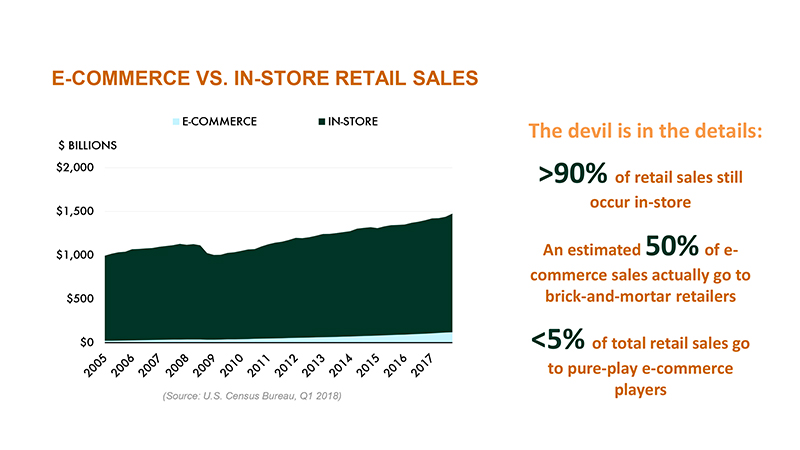Tax Reform – First Filing Season
October is the time for fall, football and pumpkin-spiced everything. (Here in the south, it’s a time for the heater in the morning and air-conditioner in the afternoon.) What else rounds out the blissfulness of fall? Tax deadlines! October is the extended filing deadline for the 2018 tax season.
The Tax Cuts and Jobs Act passed in late 2017 with many of its provisions taking place in 2018. As a refresher, below is a list of some of the major components relating to real estate business owners and investors. For a complete overview of the tax reform changes, check out my last blog here.
- Expanded Bonus Depreciation – an increase from 50% depreciation to 100% bonus depreciation of certain items with a 15-year life or less
- Qualified Business Income Deduction – 20% of the taxable income generated from a business could be eligible for a deduction pending multiple limitations
- Property Tax Deduction – remained in place for real property trade or businesses
- Interest Expense from Loans – remains deductible for entities generating less than $25 million in gross receipts and are not considered a tax shelter
- 1031 Exchanges – real estate continues to benefit from 1031 exchanges
With our first filing season behind us, we’ve seen firsthand how these reforms resulted in significant tax savings for our investors. In 2018, we completed a $6 million development that yielded over $1.8 million in year one depreciation expense. Prior to the Tax Cut and Jobs Act, only $900,000 of depreciation would have been allowed in year one, with the remaining amount spread across 5, 7 and 15 years.
For individuals, many investors benefitted from the new Form 1040: Line 9 – Qualified Business Income Deduction. This tax revision now offers some tax relief for rental real estate entities rising to the level of a trade or business. The deduction, referenced in bullet point #2 above, provides a 20% deduction from taxable income generated from your qualified trade or business investments. This new deduction has brought about substantial tax savings for individuals, sometimes resulting in the thousands of dollars. This deduction will remain in place through 12/31/2025.
Evidently, real estate investments do provide some tax and asset diversification benefits. When asked about real estate as an investment alternative, Randy Waesche, CFP, of Resource Management, said, “Many of my investors seek real estate as an alternative to stocks and bonds. It adds a level of diversification in asset class, as well as a different risk and return profile. On a risk vs. return basis, investors are seeking real estate for the 6-8% tax-deferred annual distribution that is significantly higher than a short-term municipal bond or ten-year treasury yield. Real estate has many attractive investment qualities. In the low inflation, low growth economic environment we have today, strong tax-deferred returns are attractive for investors. My clients invest tens of millions of dollars in real estate annually.”
As we have previously reported, the Tax Cut and Jobs Act has been beneficial for the real estate industry and we expect it to continue to spur opportunity in the real estate market. At Stirling Properties, we will also continue to find ways to benefit our investors and real estate assets.
Disclaimer: The information contained herein is intended for information purposes only. Individuals should seek advice directly from a qualified professional before making any decisions or taking any action that might affect your personal finances or your business. Stirling Properties is not responsible for any investment or monetary decisions made based on the information provided above and is not a tax advisor. The information provided above was done so with the perceived intent of the legislation and not based on the actual regulations. The actual regulations could yield significantly different results.
How Do I Calculate the Value of My Commercial Real Estate Property?
Whether you are looking to buy or sell a commercial real estate property, it’s important to be very clear on its value. Value is defined as the most feasible price the property could reasonably earn in an active, open, and competitive market when the transaction is approached fairly and knowledgeably by both buyer and seller. There are three different approaches that are typically used to appraise a commercial property and choosing the right method for your particular investment is essential to ensuring that it is priced correctly. Let’s look at these three approaches separately.
The Income Approach
Also referred to as the Income Capitalization Approach, this tactic is the one most commonly used in commercial real estate transactions. The value is established here by estimating the property’s income using the capitalization rate (commonly referred to as merely the cap rate). The cap rate is the net operating income of the property divided by its current market value (or sales price).
An example might look something like this: Take a property with a gross potential income of $500,000, subtract a 10% vacancy factor of $50,000 and you will be left with an effective gross income of $450,000. Deducting from this the operating expenses of the property (we’ll say $150,000) will help you to arrive at a Net Operating Income (or NOI) of $300,000. Divide this by the cap rate (8%), and you will come to your fair market value price of $3,750,000.
The Replacement Cost Approach
Frequently shortened to The Cost Approach, this is a much more complicated route of valuing commercial real estate properties. It first considers the value of the land on which a building exists (value without the inclusion of the building). It then factors in what costs would be incurred to build an exact reproduction of the current existing building and adds that number onto the land value. Lastly, the depreciated value is considered, and the actual property value number adjusted accordingly.
The Market Value Approach
Sometimes called the Sales Comparison Approach or the Comparable Approach, the Market Value Approach is quite arguably the simplest method to determine the value of a commercial real estate property. This type of method compares the property in question to other properties of similar use and size, which have been sold or placed on the market in the surrounding area. A range of value is established from the findings of the market research, and from there, the number is adjusted based on the physical characteristics of the property being valued.
Factors that will likely be considered are discrepancies in the dates of the sale, age and condition of the property, square footage of the actual building and size of surrounding land, location, land to building ratio, local tax policies, and other physical characteristics based on the importance they hold in the current market and the effect they have on the particular property being valued. Basically, this number is determined by what a purchaser is likely willing to pay in an open, fair, and competitive market at any given time. A buyer may put a less or greater personal value on a property based on how it serves their needs, but this is an easy way to determine a baseline to begin negotiations between two parties.
Which Approach is Right for Me?
Now that you have a much clearer picture of each of these fundamental valuation tools, you may be wondering which method is right for your commercial real estate property. The short answer is that each of these modalities is valuable depending on your situation. For example, it’s going to be harder to determine cap rates and comparable selling prices for a property that is located further away from similar properties; in which case, The Replacement Cost Approach may make the most sense. If you have access to the data needed to determine the cap rate, The Income Approach will be sufficient. If you have a property where vacancy rates fluctuate (such as a multifamily building), this may not work out so well; in which case, you might consider The Market Value Approach of using comparables.
Looking for Commercial Real Estate in the Gulf South region?
If you’re ready to sell your commercial real estate property or looking to invest, it’s imperative that you are clear on a property’s actual worth. Working with a professional can help you avoid mistakes and pitfalls. At Stirling Properties, our experienced team of commercial advisors is here to make your venture a success. With offices throughout Louisiana, Mississippi, Alabama and the Florida Panhandle, we have specialists in all aspects of commercial real estate including retail, office, industrial, healthcare and multifamily sectors. You can’t go wrong having us on your side. Please take a look at our extensive database of commercial properties and contact one of our expert team members today!
Have no fear, for the death of retail is not near
Beware! Caution! Warning! These are just a few of the wicked things we have heard about brick-and-mortar retail over the last couple of years, but it’s just a bunch of hocus-pocus.
This month, it seems something else is brewing in the industry: optimism. According to a recent survey conducted by the National Retail Federation, Halloween spending is projected to hit $9 billion this year! That’s the second highest in the survey’s 14-year history, just missing last year’s record $9.1 billion in sales. More than 175 million Americans are planning to participate in Halloween festivities, each spending an average of $87, also up from last year.
Despite the myths that still haunt the retail industry, the truth is that overall retail is thriving. Thanks to a robust economy, retail sales have increased year over year since 2015—forecasters are expecting a 4.5% growth for 2018. Consumer sentiment is high, with the index topping 100 for only the third time since January 2004.
Fact-based analysis shows that consumers are still spending; they are merely spending differently. We’ve heard the horror story of the bloody battle between physical stores and e-commerce, but it’s not what it appears to be. In fact, e-commerce still only accounts for less than 10% of total retail sales. Furthermore, over half of those online sales are actually generated by brick-and-mortar retailers!
Many brick-and-mortar retailers are spending billions of dollars on their online platforms and supply chain networks. It’s the brick-and-mortar retailers driving the e-commerce.
Indeed, many once pure-play retailers are now opening brick-and-mortar stores—e-commerce retailers plan to open 800 physical stores in the next five years. Mattress startup Casper is rolling out a brick-and-mortar strategy, men’s retailer UNTUCKit is opening stores across the country, Blue Nile, Peloton, Birchbox, and the list goes on. Even online furniture giant Wayfair is dipping its toe in physical stores. As they say, “If the broom fits, fly it.”
It might sound batty, but research shows 78% of consumers prefer to shop in-store and spend significantly more in physical stores than online. On top of that, e-commerce is expensive. With the high cost of delivery and even higher cost of returns, it is virtually impossible to make a profit through pure online tactics. Successful retailers are maximizing sales by leveraging both brick-and-mortar and online strategies.
Looking a bit down the road, a new holiday forecast offers even more good news. Retailers are poised to rack up their best sales in years this season. Holiday sales between November and January are estimated to grow 5% to 5.6% from last year to more than $1.1 trillion, up from the $1.05 trillion last year, according to Deloitte’s annual holiday retail sales forecast.
So have no fear, the death of retail is NOT near. However, with all of the retail tales of terror, it can be confusing and overwhelming, especially for commercial real estate investors and property owners. Evolution in the commercial real estate industry is creating rapid change. This new landscape is impacting real estate values—presenting both problems and opportunities in the market—and increasing the need for professional real estate guidance for investors and property owners.
That is why Stirling Properties recently formed a new Investment Advisors division that specializes in acquisitions, dispositions, and investment sales of retail assets and other property types.
Stirling Properties’ Investment Advisors division has the depth and breadth of experience to help solve problems and maximize the potential of commercial investment assets. Our team can help to assess the risk and rewards of any asset or investment and guide clients through difficult decisions. Stirling Properties’ Investment Advisors represent a wide range of client types, including private owners, institutional investors, and private equity firms.
October is full of enough frightening experiences, your real estate portfolio doesn’t have to be one of them. If you are unsure how to navigate the complexities of the retail industry or other commercial sectors or are interested in exploring commercial asset opportunities, let our investment advisors help you sort through the cobwebs. Contact one of our experienced agents today.
On behalf of Stirling Properties, we witch you a Happy Halloween!
Stirling Properties Forms Investment Advisors Division
Stirling Properties commercial real estate company is expanding its depth of services in the Gulf South region through the formation of an Investment Advisors Division. The company’s acquisition, disposition, and investment sales efforts will be consolidated under one departmental umbrella.
Marty Mayer, President & CEO of Stirling Properties, said, “Evolution in the commercial real estate industry is creating rapid change, increasing the need for professional real estate advice and guidance for investors and property owners. Deepening our services through the formation of an Investment Advisors Division will help us to better elevate, promote, and brand the capabilities of Stirling Properties in this arena.”
Stirling Properties’ Investment Advisors Division will be led by Beezie Landry, Vice President of Investment Advisors. Landry began his career at Stirling Properties more than 17 years ago. Over the last few years, he has been responsible for the acquisition and disposition of nearly $500 million of investment assets in Louisiana and Mississippi, focusing on single and multi-tenant retail and medical office. He has represented a wide range of client types including private and institutional investors and has completed transactions with REITs such as Weingarten Realty Investors, General Growth, VEREIT, Realty Income, and AEI Funds.
Stirling Properties’ Investment Advisors also welcomes seasoned professional Chad Rigby, CCIM, as Managing Director-Multifamily Sales. Previously, Rigby worked with Stream Realty, ARA Newmark, and most recently, with Rigby Advisors where he was responsible for all aspects of multifamily investment sales from transaction management, valuation, market analysis, and underwriting, to client development throughout Louisiana and Mississippi. He has transacted over $500 million, totaling approximately 7,000 units. Rigby holds a B.S. in International Trade and Finance from Louisiana State University and is a licensed real estate associate broker in Louisiana and Mississippi.
In addition, three other Stirling Properties’ agents will become part of Stirling Properties’ Investment Advisors. Jeff Barnes, CCIM, has been named Senior Investment Advisor, and will work from the company’s Mobile office; Saban Sellers has been named Investment Advisor-Multifamily, and will work from the New Orleans office; and Griffin Lennox will serve as Investment Advisor and Analyst, working from the Northpark office in Covington.
“Our vision for Stirling Properties’ Investment Advisors is to build one cohesive team with specific expertise across all property types that will add tremendous value for our clients,” said Landry. “I am proud to say that we have assembled a fully integrated team consisting of advisors, analysts, and marketing specialists with unsurpassed local market knowledge and a proven track record of results.”
“I am incredibly excited to join the team at Stirling Properties and work with them to build a new and robust Investment Advisors Division. My background in multifamily investments will help to benefit a diverse range of clients,” said Rigby.
Louisiana State University Takes 3rd Place (Again!) In Global ARGUS University Challenge
Continues to propel national spotlight on growing educational real estate programs at LSU
Stirling Properties commercial real estate company is pleased to announce students from Louisiana State University (LSU) E.J. Ourso College of Business were awarded 3rd place in the global 2017 ARGUS Software University Challenge.
Since 2011, ARGUS Software has hosted the competitive challenge for university students from around the world aspiring to be commercial real estate professionals. Through this challenge, students create real-world investment strategies through informed decisions using ARGUS Software solutions. The theme of the case this year was Pokémon GO! A panel of judges from the academic community and real estate industry participated in reviewing the case studies and nominating the winners.
More than 30 top real estate programs from universities worldwide participated in the competition. The University of San Diego won 1st place, Cornell University placed 2nd, LSU took 3rd, and UCLA earned an honorable mention.
The team from LSU—Garrett Choate, Whitney Gaulter, Matt Hingle, Tyler Tamboli, Sophie Weber, Jason Wyman, and Cassius Dsouza—was coached by Stirling Properties Vice President of Finance, Justin Landry. Landry serves as an adjunct professor teaching Finance 7720 (Commercial Real Estate Investing). This is the 6th year he has taught the course and the 6th year an LSU team has competed in the ARGUS Challenge. It also marks the 2nd time placing under Landry’s leadership.
“This is the second consecutive year that we have secured a 3rd place finish in this competition, so it is no longer beginners luck! This win will certainly garner larger attention around the nation for LSU real estate programs and for students who seek a career in the industry. I am very proud of this team for their accomplishments—they have really worked hard,” said Landry.
LSU’s team secured $3,000 for the university through ARGUS Software. In addition, the students were bestowed the 2017 ICSC (International Council of Shopping Centers) Maurin-Ogden Foundation LSU Scholarship Award, funded by Jimmy Maurin and Roger Ogden, founders of Stirling Properties. Through the scholarship, students will receive all-expense-paid attendance to the ICSC RECon in Las Vegas, the world’s largest retail real estate convention. Each year Stirling Properties hosts LSU Award Recipients at the conference, offering the students valuable exposure to industry leaders and potential employers.
“We truly thank Stirling Properties’ founders, Jimmy Maurin and Roger Ogden for their generosity and unwavering commitment to LSU, real estate, and education. This is an invaluable opportunity for these students to meet and network with industry leaders. Many of our students in the past have garnered great job prospects through this experience,” said Landry.
For more information about Finance 7720 (Commercial Real Estate Investing) and its objectives, contact Justin Landry at jclandry@stirlingprop.com.
Stirling Properties is located at 109 Northpark Blvd., Suite 300 in Covington, Louisiana. For more information regarding our services, please visit us at www.stirlingproperties.com.
Louisiana State University Takes 3rd Place In Global ARGUS Software University Challenge
Propels national spotlight on growing educational real estate programs
Stirling Properties commercial real estate company is pleased to announce students from Louisiana State University (LSU) E.J. Ourso Business School have placed 3rd in the global 2016 ARGUS Software University Challenge.
For the past several years, ARGUS Software has hosted the competitive challenge for university students from around the world aspiring to be real estate professionals. Through this challenge, students create real-world investment strategies through informed decisions using ARGUS solutions. A panel of judges from the academic community and industry participated in reviewing the case studies and nominating the winners.
More than 40 top real estate programs from national universities participated in the competition. The team from LSU—Jason Wyman, Eddie Saa, Jacob Kerr, Alysha Meadors and Robin Day—was coached by Stirling Properties Asset/Finance Manager, Justin Landry. Landry serves as an adjunct professor teaching Finance 7720 (Commercial Real Estate Investing). This is the 5th year an LSU team has competed in the ARGUS Software Challenge, and marks the 1st time placing under Landry’s leadership.
“Our team is thrilled to have placed among the top three teams in the country, especially among such prestigious schools and highly respected real estate programs,” said Robin Day, 2016 ARGUS Software University participant from LSU. “We were given the invaluable opportunity to learn from real-world scenarios. The challenge was a direct correlation to the types of trials real estate industry professionals encounter on a daily basis. Working as a team from various backgrounds allowed us the chance to share ideas and learn from one another. We created a more robust solution by combining our diverse knowledge bases than any of us could have accomplished individually.”
LSU’s team secured $2,000 for their university through ARGUS Software. In addition, the students were bestowed the 2016 ICSC Maurin Ogden Foundation LSU Scholarship Award, funded by Jimmy Maurin and Roger Ogden, founders of Stirling Properties. Through the scholarship, students will receive all-expense-paid attendance to the ICSC RECon Convention in Las Vegas. Each year Stirling Properties chaperones five LSU Award Recipients to the convention, offering the students valuable exposure to industry leaders and potential employers.
“This scholarship has been tremendously successful, and we’ve had a handful of students who received jobs as a result of attending the conference. But none of this would be possible without the generosity of Stirling’s founders, Jimmy Maurin and Roger Ogden. There are no two people more committed to LSU, real estate and education,” said Landry. “We couldn’t be more proud of this team of students. They have worked so hard for all that they have accomplished this semester.”
Coming on the heels of other recent LSU E.J. Ourso Business School advancements, this is another significant win that students and supporters hope will propel a national spotlight on the growing finance and real estate programs at the university.
For more information about Finance 7720 (Commercial Real Estate Investing) and its objectives contact Justin Landry at jclandry@stirlingprop.com.
Stirling Properties is located at United Plaza, 8550 United Plaza Boulevard, Suite 303 in Baton Rouge, Louisiana. For more information regarding our services, please visit us at www.stirlingproperties.com.








